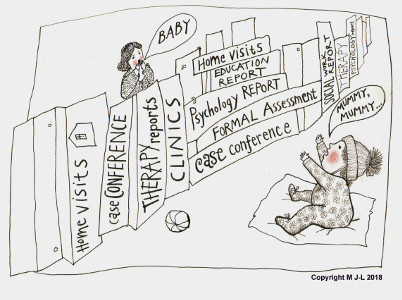How we get in the way between parents and infants with disabilities. Can you help?
 'Why do we think it is OK to endanger attachment and bonding in our drive to offer multiple professionals and programmes?'
'Why do we think it is OK to endanger attachment and bonding in our drive to offer multiple professionals and programmes?'
Peter Limbrick writes: Some babies and young children need a lot of support as they develop and learn. This might be because or prematurity, lack of oxygen at birth or another reason. Support can be needed for vision and hearing, posture and mobility, cognition and communication. For an increasing number of children, support will be needed for all of these aspects of development and learning.
In many countries, the response is to flood the infant and family with a host of discipline-specific professionals, all with separate programmes and all ready to make demands on child and family. The prevailing attitude can be that the family are expected to fit in with the needs of the professionals and their agencies.
There are great dangers here: the whole family can become stressed and exhausted; the child has no time to enjoy childhood; parents and child have no quality of life; separate disciplines are not integrated for the whole child.
But the problem I want to highlight here is the wall we build between infant and parents that impedes the necessary processes of attachment and bonding. We all know attachment between children and parents (or other caring adults) is very important indeed. It sets the scene for future wellbeing and relationships and creates confidence and resilience.
Perhaps you know more than I do about attachment theory, but I assume necessary conditions include some quiet times for parents and infants to get to know each other and enjoy each other’s company, a safe space free from intrusion of non-family people, and a degree of mental calmness in child and adults. This feels like common sense.
So why do we forget all of this when the infant has some sort of special needs? Why do we think we can endanger attachment and bonding in our drive to offer multiple professionals and programmes? Is it because we believe our interventions are so much more important than the relationships between child and family members? Is it because our traditional systems do not respect disabled young children and their families sufficiently? Is it because we are incapable of seeing infants with special needs as ‘just children’ who have a right to a decent quality of life?
It does seem we can too easily focus on disabilities without seeing the child and family under our nose!
My headline has a request for help. I would like to gather and disseminate any information that relates attachment theory to infants who have disabilities or other special needs. Please send me any information or references that you know of.
This email address is being protected from spambots. You need JavaScript enabled to view it.
Cartoon for TAC Bulletin Issue 216:


